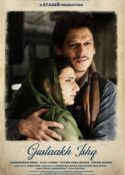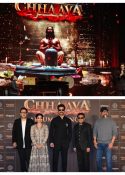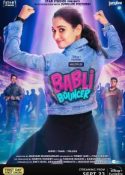 In a new installment of his This Day That Year series, Subhash K Jha looks at the time when Sunny Deol spoke about Bobby starring as Bhagat Singh in 23rd March 1931: Shaheed.
In a new installment of his This Day That Year series, Subhash K Jha looks at the time when Sunny Deol spoke about Bobby starring as Bhagat Singh in 23rd March 1931: Shaheed.
It’s easy to dismiss this as yet another Bhagat Singh bio-pic, 23rd March 1931: Shaheed, in the current cascade of such films, more so when the director Guddu Dhanoa doesn’t have the reputation of making particularly classy films.
But Dhanoa’s version of the by-now familiar story has its own smouldering intensity. It projects a vitality quite dissimilar to Raj Kumar Santoshi’s The Legend Of Bhagat Singh . And yet , the vitality in 23rd March 1931 Shaheed is no less vital.
An organic intensity runs through Dhanoa’s exacerbated narrative. Sometimes, specially in the second-half he gets carried away with all the bombastic outpouring of rhetorics and rhyme -–‘screams’ that patriotic films in mainstream Hindi cinema have patented over the years.
Frankly, the trial of Bhagat Singh, Sukhdev, and Rajguru is fairly farcical on more than one level. The back-and-forth of arguments, with a Muslim lawyer (Sachin Khedekar) volunteering to defend the three accused (giving out banshee cries of “Inquilaab Zindabad” in the courtroom!), is embarrassingly earsplitting. And then the whole episode in jail with Suresh Oberoi playing a jailer who’s a hard nut to crack, is overdone and too lengthy to sustain our interest.
But the absence of subtlety and the presence of overt drama are not, in themselves, inherent disadvantages in a film that speaks of fiery rebellion during times of stressful struggle. The film is a long, loud, and flamboyant paean to patriotism.
Flaming orange colours coalesce with the unaffected yellows of sarso fields in Punjab to bring alive an era and ethos when love for the country superseded all other affections, including the one for the sweetheart. And never mind if she happens to be Aishwarya Rai prancing around in a pastel salwar-kameez trying desperately to look like a rural Punjabi lass.

The fact that Ms Rai is so at odds with the mood of the film is a backhanded compliment to Dhanoa’s high-pitched but well-aimed ode to patriotism. He gets great support from an unusually skilled crew. The crowd scenes, far more impressively staged than in Santoshi’s Bhagat Singh, recreate the volatile times with surprising accuracy.
We can’t fault the film’s visual vitality. From the Jallianwala Bagh massacre (skilfully edited to appear as flashes in little Bhagat Singh’s mind) to the final execution of Bhagat Singh and his two associates, the aura of the era is irradiated with splendid strokes of authenticity.
Cinematographer Thiru’s work is quite simply extraordinary. He paints the frames in shades of blood and tears. True, Anand Raaj Anand’s songs cannot hold a candle to A.R.Rahman’s music in Raj Kumar Santoshi’s epic. But Anand goes for a rawer repository of rhythms that seem more from the heart than art.
The emotional content of the narrative is strong. Dhanoa has worked to build a special rapport between Bhagat Singh and another child of the Quit India Movement, Lala Lajpat Rai (played by Raja Bundela) and his death in the hands of British brutality serves as a remarkable link in Bhagat Singh’s life story.
Also poignant and intensely conceived is Bhagat Singh’s special rapport with his mother. Though Amrita Singh, making a comeback in the mother’s role seems to have got a little rusty in her acting, she nonetheless brings a lump to the throat when she meets her martyred son for the last time.
On the deficit side, Bhagat Singh’s two associates, Sukhdev and Rajguru, are shadowy figures. Rahul Dev’s Sukhdev is no patch on Sushant Singh’s brilliant portrayal in Santoshi’s film. Among the actors who play Bhagat Singh’s associates, the grossly underutilized Divya Dutta stands out in a brief role. Since hers was the only female revolutionary’s part, Dutta’s role should’ve been fleshed out.
Naturally the scenes between Bhagat Singh and Chandrashekhar Azad are expected to be strong, since the two roles are played by Bobby and his superstar-brother Sunny Deol . Though Sunny as Azad makes his presence strongly felt, and his massacre in a park is one of the film’s memorable passages, there’s a surprisingly lack of empathy between the brothers.
Bobby Deol as Bhagat Singh is a surprise. The tempestuous warmth and youthful vitality of the character reach his eyes quite effectively. Mothers in the audience would want to cuddle this Bhagat Singh close to their bosom.
Instead of ridiculing the other national leaders from the Quit India movement like Mahatma Gandhi and Jawaharlal Nehru , like the two other Bhagat Singh bio-pics this film avoids showing Gandhi or Nehru entirely, to concentrate on the impetuous martyr Bhagat Singh whose popularity at one time was as high as Gandhi’s.
Comparisons between the two Bhagat Singh films this week are inevitable. So it won’t be fallacious or facetious to say Raj Santoshi’s film is like Lagaan while this one, with its rich riot of rabblerousing rhetorics and kinetic drama is the Gadar of 2002. And a work of melodramatic art that does producer Dharmendra and Sunny Deol proud.
Sunny Deol told Subhash K Jha he was very angry that his ex-protegee Raj Kumar Santoshi making his own Bhagat Singh biopic. “It is now up to the audience to decide which film is most authentic. This is one project which I’ve believed in from the word go. There’s no fear or threat from any quarter simply because we believe in what we’ve created, and no one can take that away from us. In fact, I look upon so many films on Bhagat Singh at the same time as a positive happening. This has made the public aware of Bhagat Singh’s importance. Otherwise, how many of our national leaders get noticed in cinema in such a huge way? I guess it is a little too much. But we’re distributing our own, and we know the curiosity among the public for knowing more about him. And we also know which of the films on Bhagat Singh has aroused the most curiosity among moviegoers. After seeing the trailers and stills, everyone feels Bobby and our film are closer to history than the other products claiming to be authentic depictions of Bhagat Singh’s life. We don’t want to make any claims about our picture. Let the audience decide.
Adding, “I have always been fascinated by Bhagat Singh. Now I see Bobby fulfilling my dream. It was always my dream to make a film on his life at a time when no one else was thinking about it. Suddenly, everyone seems to have woken up to Bhagat Singh. I had heard Raj Santoshi was planning to make a movie on Bhagat Singh while we were planning our own. So I asked Santoshi to join us. But he had objections to my brother being cast as Bhagat Singh. He said Bobby couldn’t play Bhagat Singh because he didn’t look like him. Now when Bobby has played the role, people have an entirely different story to tell. If Santoshi has done as much research on Bhagat Singh as he claims, he should have at least known what the man looked like. Every director knows that if the actor resembles the character, then half the battle is won even before shooting. For a film to look authentic, the characters have to look right.”
Sunny Deol played another freedom fighter in the film. “History tells us Chandrashekhar Azad was Bhagat Singh’s inspiration. We’ve gone into only Bhagat Singh’s life in detail. But I’m there for nearly 30 to 40 per cent of the footage. Initially, we tried to include Mr Manoj Kumar in our project. Unfortunately, things didn’t work out. Contrary to rumours, our film isn’t a remake of Manoj-ji’s starrer Shaheed in the 1960s. Our Shaheed is a completely original film. Of course, since both films are based on Bhagat Singh’s life, the basic facts are bound to be the same. It makes no difference what people say. At the end of the day, the product speaks for itself. For me, the success of this film will mean a lot. Somehow, everything has worked out in spite of all odds. I feel God has guided our project forward. Otherwise, it wouldn’t have been possible to complete the film in four months.”
There was a massive fire destroying the film’s sets.
Said Sunny, “It wasn’t a nice thing to happen. But since we made the film on a war footing, we were ready for any eventuality. We never allowed our morale to sag. Our whole team was so enthused that every setback made us even more determined. When such catastrophes occur, all sorts of dark thoughts cross the mind. But we really didn’t want to be bogged down by such suspicions. I left it to the authorities to make their investigations and come to their own conclusions. When I heard the news in Canada, I was very angry and upset, and wanted to fly back immediately. I couldn’t because of my shooting commitment. Luckily my crew was shooting when the fire happened, so it could be quickly controlled. Otherwise, everything would have gone up in smoke. We would’ve lost the ten sets that we had erected for the film.”









